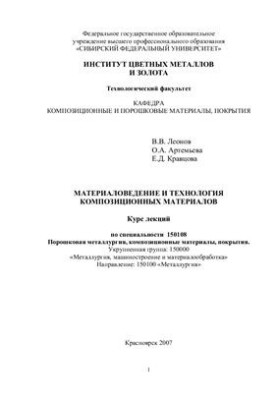Materials Science and Technology of Composite Materials
 Instant download
Instant download
after payment (24/7)
 Wide range of formats
Wide range of formats
(for all gadgets)
 Full book
Full book
(including for Apple and Android)
Course of lectures . - Krasnoyarsk: SFU, 2007. -241s. Over the past decades, composites have actively entered our lives and replaced traditional materials in energy, transport, electronics and other fields of activity. Composite materials (CM) are materials of two, three or more heterogeneous phases (substances) in one volume. They are uniform at the macroscale, but heterogeneous at the microscale. Currently, the compositional materials include a relatively small group of materials - polymers, metals, ceramics and carbon reinforced with fibers, as well as filled polymers, particulate-hardened alloys and pseudoalloys .. The difference between most composite materials and traditional ones is that the process of their manufacture can be combined with the manufacturing process of the product. The rapidly growing demand for composite materials requires the training of specialists in this field. The proposed series of lectures is intended for in-depth training of specialists in the field of obtaining, using composite materials, creating structures from them . The course examines the history and principles of composite materials (CM) ; Types and materials of dispersed and fibrous inclusions ; Materials of the matrix ; combination of different inclusions and matrix in one KM ; Manufacturing technology KM and their properties ; prediction of the composition and technology of KM with specified properties ; Application of composite materials. In the course of lectures, the conclusions are mainly given only those formulas that are used in software for assessing the properties of composite materials . Features of mechanical behavior and technologies for obtaining composite materials based on ceramic, polymer and metal matrices are considered. Composites reinforced with continuous and short fibers are analyzed, as well as filled composites. For the successful development of this course, it is assumed that students have a good knowledge of the basics of mechanics and physics, as well as the basics of materials science. The information that students get acquainted with in this course can be used to assess the complex of physical and mechanical properties of composite materials, the choice of optimal compositions, and the justification of manufacturing technology. Each lecture is equipped with questions on which you can independently control the assimilation of material . The list of recommended literature is given for each section of the theoretical material and is divided into two parts: the main and additional . The list of additional literature includes links to relevant sites for this course. Nikiforova E . M. , Kravtsova E. D. Materials Science and Technology of Composite Materials. Methodical instructions for laboratory work
LF/722538006/R
Data sheet
- Name of the Author
- Артемьева О.А.
Кравцова Е.Д.
Леонов В.В. - Language
- Russian















